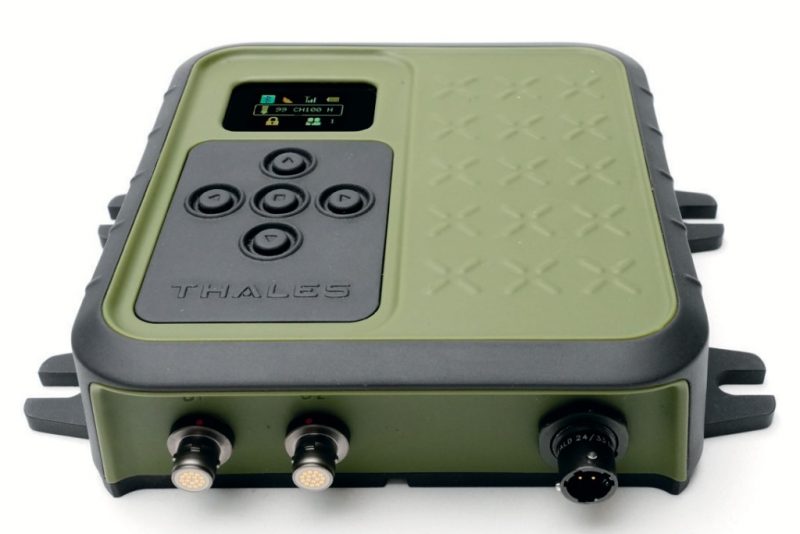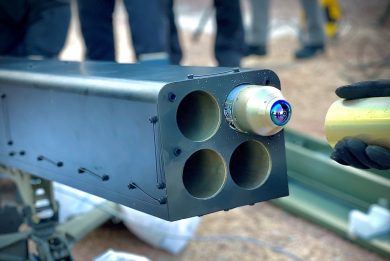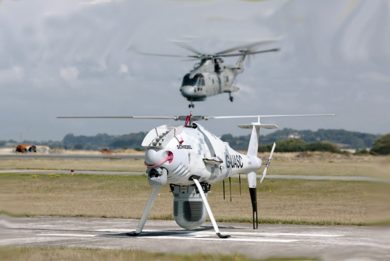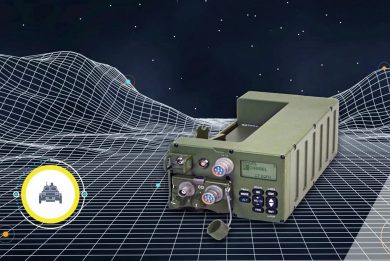Thales unveils new Vehicle Mounted SquadNet Radio
At the Future Soldier Technology 2025 Conference, which is taking place at the Marriott Hotel Grosvenor Square in London, organized by ASDEvents, Thales unveils its new Vehicle Mounted SquadNet Radio, designed to enable secure voice and data services to be shared seamlessly between platform and soldier
With over 23,000 SquadNet soldier radios sold to numerous customers, among them Austria, Belgium and Ireland, 18,000 of which have already been delivered while the remaining 5,000 will be delivered in 2025, with more opportunities to come. Unveiled 10 years ago, the 250 grams radio, this figure including the 3.7 V battery that ensures a 24-hour operational life, the SquadNet allowed Thales to enter the low-tier radio market with a light, simple and relatively unexpensive radio, which can be issued to every single infantryman. And adding only 180 grams, the mass of two additional batteries, provides a 72-hour autonomy. Designed and produced in the UK, the SquadNet ensures encrypted data and voice connectivity as well as Blue Force Tracking (BFT) thanks to the embedded GPS receiver. Several waveforms were developed, the standard one featuring automatic ‘3-hop’ Networking capability for more reliable and longer-range communications.
Low Probability of Detection, Anti-Jam, Full-Duplex and Dual Voice Net waveforms are also available. “We had a European customer who bought the SquadNet and wanted to be able to have four different nets at the same time on the radio; so, we created the Multiple Voice Mode waveform which is able to support four simultaneous voice nets,” Ciaran McCloskey, Product Line Manager, Tactical Products for Thales UK explained to EDR On-Line. To do so the company fully exploited the Time Division Multiple Access technology, he added.
With the launch of the Vehicle Mounted SquadNet Radio, VMSR in short, Thales links the vehicle to the dismounted soldier and vice versa.
“The first use of the VMSR is to ensure full coordination between the vehicle and dismounted troops, allowing the vehicle commander to see on his screen where the infantrymen are deployed,” Mr. McCloskey illustrates. The second use case is to bring into the vehicle all data acquired, therefore should a soldier have a targeting binocular, and should the infantry team be unable to engage it with its weapon systems, the infantryman sends precise target grids in near real time to the combat vehicle that can eventually deal with it or pass information at the relevant effector. Because the VMSR allows to convey voice and data coming from soldiers’ SquadNet radios to upper echelons using other communication assets available on board, VHF, UHF or SATCOM radios. This includes photos, while videos cannot be relayed by SquadNet radios; “It was a very deliberate trade-off,” McCloskey explains, “because when you move into video you start to get into wideband transmissions, which shorten your range, reduce battery life, and makes comms easy to detect.” According to the Thales representative the 250 mW output represents in some cases one tenth of that of some competitors, the SquadNet beating them significantly on range thanks to the narrowband choice.
Of course, information coming from dismounted infantry can be fed into the vehicle battle management system (BMS); to this end, the VMSR is integrated with systems such as ATAK and SitaWare, which are used by many first-tier armies. Should a customer not be equipped with a BMS, the SquadNet is fully interoperable with Thales Sabre C2 application. It is a basic command and control application that allows for example to overlay BFT data on a map, as well as targets provided dismounted infantry. It also allows to send and receive text messages and images. “It is an easy entry point into digitalisation, for those armies who have not yet made a step in that direction,” the Thales UK representative said.
The final use case made by Mr. McCloskey is about the improvements that the VMSR bring to the dismounted team communications. “The better antenna installed on the vehicle allows many communications to pass through the VMSR and be re-routed to the recipient of the call, extending the range or allowing the communication,” the vehicle-mounted system acting as a more effective node of the mesh.
He also makes clear that the VMSR is not a vehicle-to-vehicle radio; this has a much longer range and different features, he said. “The VMSR was developed when a SquadNet customer asked if it was possible to design a radio that could fit into a vehicle. “We have taken the SquadNet radio, we have added a suitable power supply so it can exploit the vehicle’s batteries, and we have changed the mounting mechanism. So, it is quite a small unit, pretty different from traditional vehicle radios, which can be quite cumbersome and bulky,” Ciaran McCloskey tells EDR On-Line.
The VMSR weighs 250 grams, it is 200 mm long, 100 mm wide and 60 mm thick, and can be powered with 12-24 V DC. “It can be mounted on a radio rack, on a bulkhead, on a panel, even in a seat headrest,” McCloskey adds, explaining that these makes it easier mounting them also on “white vehicles”, commercial vehicles that are not fitted with standard military racks.
Its output power is the same of the handheld radio, 250 mW, and it obviously works on the same two frequency bands, 431-470MHz or 865-880 MHz, 90% of the boards of the receiving and transmitting elements being identical. All waveforms are obviously the same available for the SquadNet. What changes are the interfaces. “In the VMSR we split data and voice services, therefore we have a greater number of interfaces.” On the top of the box, we find the antenna plug on the right and a small plug on the left, the latter being used for adding an external GPS antenna when needed, such as in heavy armoured vehicles. At the bottom we find the power input at the right and two 16-pin connectors: the first plugged in takes the audio channel, the remaining the data one. A typical five keypad allows navigating in the VMSR menu; in fact, the new product can keep in memory 100 different configurations, therefore it is usually sufficient to select one of those available depending on the situation.
The Vehicle Mounted SquadNet Radio is in the last development phase, and prototypes have already been handed out to potential customers in 2024, EDR On-Line understood. “We have a launch customer, the contract is signed,” Mr. McCloskey unveils, without of course giving us further details, adding however that “We will deliver to the customer in 2026 the 500 units that they’ve ordered for their vehicles.”
Photos courtesy Thales






